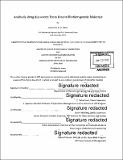Antibody drug discovery: From Idea to Biotherapeutic Molecule
Author(s)
Davis, Katherine A. D
DownloadFull printable version (22.60Mb)
Other Contributors
Massachusetts Institute of Technology. Department of Mechanical Engineering.
Advisor
Retsef Levi and Daniel Whitney.
Terms of use
Metadata
Show full item recordAbstract
Graybel (a fictitious name used for privacy reasons) is a large developer of pharmaceuticals. Graybel's Antibody Protein Engineering Group (APEG) is responsible for early stage drug development of biotherapeutic molecules. Part of this responsibility is delivering high quality molecules while meeting tight deadlines. Across the industry there is constant pressure to decrease timelines, while at the same time the complexity of molecules is increasing. In order to meet this challenge, APEG must be highly adaptable. Unfortunately, unanticipated biology, long project lead times, unpredictable workflows and inadequate workflow tracking systems make it difficult to precisely determine what causes delays. This uncertainty, combined with the inability to quickly pilot changes to process or methodology, makes each potential change both risky and costly. The goal of this project was to provide APEG with two things: the knowledge needed to build a robust workflow tracking system and simulations that would assist in finding root causes of issues and allow for low-cost piloting of potential solutions. Combined, a workflow tracking database and decision tool would greatly reduce the risk associated with implementing changes, allowing APEG to adapt to meet increasingly difficult industry standards. Multiple avenues were used to collect the data needed on APEG's workflow. The primary source of data is interviews, with both management and experienced bench workers. These interviews provided data on workflow paths and estimates for workflow stage durations that could not be found elsewhere. In addition, they provided a way for APEG members to be involved in the project. Additional data was gathered from rudimentary systems that are used to track workflow within some functional groups. This data was then used to create detailed process maps, and simulations. Once validated, simulation results were analyzed and experimented with to determine current bottlenecks, potential future issues and possible fixes for these problems. In addition, a new metric was introduced for quantitatively evaluating the difficulty of a project called the Technology Readiness Level (TRL). Essential project decisions were identified, and recommendations made to track those issues. Bottlenecks were identified through queue analysis. Potential changes to fix these and other issues were piloted to determine effect. Future states, both with and without these changes, were simulated to determine potential problems. From this, causes of current and potential future delay were identified and recommendations developed. Recommendations included staffing changes, cross training, real-life piloting and developing a deeper understanding of certain processes.
Description
Thesis: M.B.A., Massachusetts Institute of Technology, Sloan School of Management, 2016. Thesis: S.M., Massachusetts Institute of Technology, Department of Mechanical Engineering, 2016. Cataloged from PDF version of thesis. Includes bibliographical references (pages 90-91).
Date issued
2016Department
Massachusetts Institute of Technology. Department of Mechanical Engineering; Sloan School of ManagementPublisher
Massachusetts Institute of Technology
Keywords
Sloan School of Management., Mechanical Engineering.